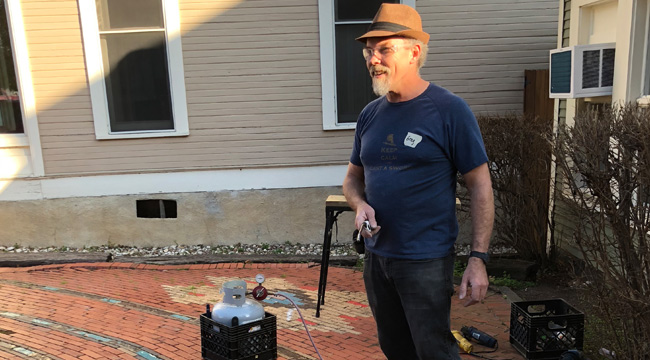
Midway through the introduction to his aluminum sword-casting class, teacher/swordmaker Greg Wenderski holds up a slightly worn-down blade, explaining that he thinks of it as his “hobbit sword.” He then asks the class — a mix of mostly tween kids and their parents, along with a smattering of unaccompanied adults — if there are any Lord of the Rings fans in attendance.
“This is kind of like my version of Sting,” he says. “A lot of Bronze Age swords were this size. I find that sometimes people with shorter arms like shorter swords.”
Wenderski teaches classes in Austin under the moniker “The Sword Casting Guy.” In these lessons, he shares the finer points of how to cast both aluminum and bronze into swords, with literary references thrown in as a bonus.
In front of him, a table is covered with rough-cut wooden prototypes and a handful of already-cast swords. Wenderski explains how some of these swords were used throughout history, which civilizations preferred which designs, and what metals they would have been made from, once upon a time.
It’s a fascinating lesson if you’re into living history. Or swords. I’m keen on both.
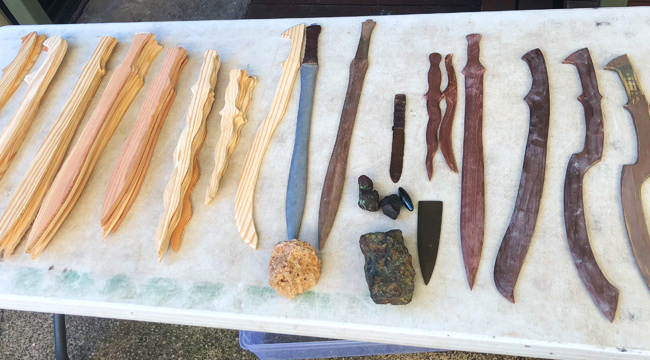
With the class underway, Wenderski explains how his passion for casting began when he was a middle-school science teacher, with a classroom just down the hall from the history department. After learning about Ancient Greeks and their battle strategies, the students would come to him and ask him to explain how the weapons they’d just heard about were made.
“Eventually, I thought, ‘Wouldn’t it be cool to show them how they made swords during the Bronze Age?” Wenderski says.
The ambitious teacher decided to take the experience to the next level. Already a blacksmith by hobby, he made a portable kiln out of an old propane tank and began teaching standalone classes for eager teens. In the ensuing years, Wenderski always found interested students — this sort of history is anything but dry — has definitely noticed spikes thanks to the current trends in pop culture.
“The explosion of swords on TV and in the movies definitely works in my favor,” he admits. “Lots of Vikings, Game of Thrones, LotR, and Forged in Fire fans come to class knowing all about the sword they want to make.”
He even tries to cross-promote, booking a sword casting demonstration for an Austin morning show to coincide with the release of the animated movie Early Man. This is the hustle required of a blacksmith in the Internet era — using techniques both old and new.
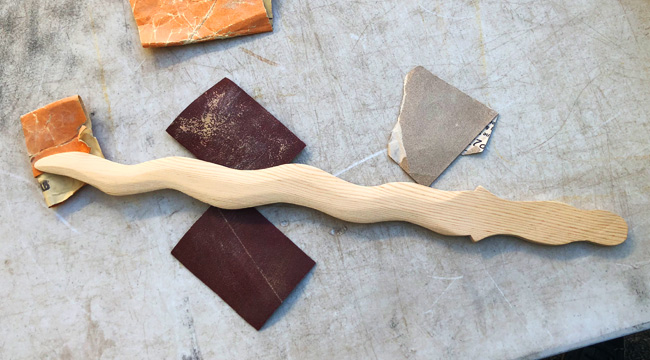
After Wenderski’s intro, we each pick the sword we’d like to cast from the handful of rough woodcuts available. They range from a Greek-style xiphos to an Egyptian-style khopesh. I choose a kris sword, patterned after a type of ceremonial Indonesian blade. While my pick may not have the practicality of something like a gladius, I’m a sucker for ornate designs.
Also, there isn’t one that looks like the dagger from The Golden Child, so my dreams of having a prop when I quote the line “My dear sweet brother Numpsay!” will continue to go unfulfilled.
Having chosen my wooden prototype, it’s off to the belt sander to refine the edges and give the wood a more sword-like shape. We’re told to keep the edges about the thickness of a quarter to avoid, you know, accidentally harming ourselves (or our classmates). Of course, Wenderski is quick to point out that ancient cultures wouldn’t have had the benefit of a belt sander, though he does quip that, “they sure would have liked it.”
Next comes the mold, which is pretty close to how swordmaking used to be done, too. We’re all given a wooden box that opens horizontally in the middle. The first step is to pack it with a mixture of mostly sugar sand, some bentonite clay, and a little bit of water. After packing it in and leveling off the top, the wooden sword is placed on top and pressed to make an impression.
If it’s too loose, the imprint won’t take. If it’s too tight, you run the risk of the wooden sword snapping in half. If the sand is packed properly, it takes a good amount of upper-body leverage to make an imprint. Once that’s done, the top is dusted with some parting powder, to help the mold open properly.
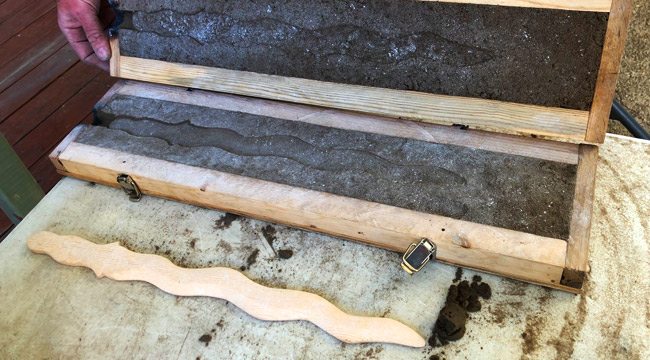
With the first impression made, Wenderski comes around to check our work, shaking up some of the loose sand inside, and reopening the boxes to make sure our imprints are intact. Mine, in particular, is better-packed at the bottom than the on top, so half of my mold is a little shaky. He explains that it’s an easy fix — simply requiring a bit more time on the sander.
After the wooden swords are removed from their molds, it’s time for the real spectacle: the casting itself. For the metal of the blades, Wenderski collects bits of aluminum from discarded bicycle frames, pieces of old ladders, and whatever else he can find. It’s not Valaryian steel, but it does the job.
When his scavenging is finished, he then melts the scrap down and pours it into small dog bowls, which make easy-to-work-with hunks of aluminum.
As the kiln reaches 1330 degrees — the temperature that melts aluminum –Wenderski lines up the boxes up vertically and pours the liquid metal through a tiny hole at the hilt’s end. The aluminum fills all the way to the top, never quite pouring over, but causing the wood to smolder and burn slightly. The boxes are then laid flat and, after cooling for a bit, are reopened for the ‘ta-da’ moment: a bright metal sword nestled in each carefully packed box of sand.
At this point, the blades are still far too hot to touch and are placed in a bucket of water to cool down.
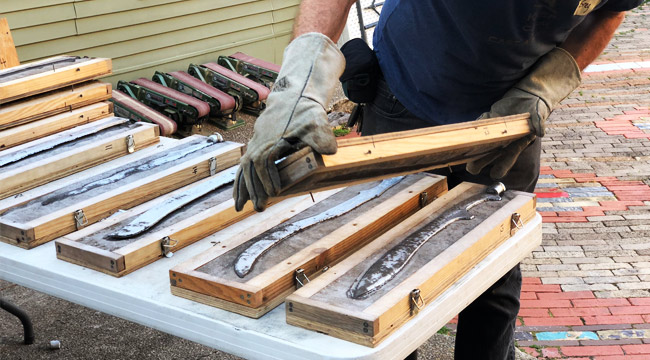
Just as Wenderski predicted, one side of my kris blade is slightly rougher than the other, thanks to the so-so job I did packing the sand. It’s an important lesson to remember the next time I take a sword-casting class. Or after our society crumbles and we revert back to a kind of post-apocalyptic feudalism. Whichever comes first.
As the swords cool, the sand from the molds is poured back into the buckets so it can be reused for the next class. Wenderski begins to grind down the imperfections on each blade. It’s another moment where modern technology comes in handy, as soldiers in antiquity would spend days grinding down their swords edges against stones.
By comparison, Greg knocks out about a dozen in an hour on a grinder.
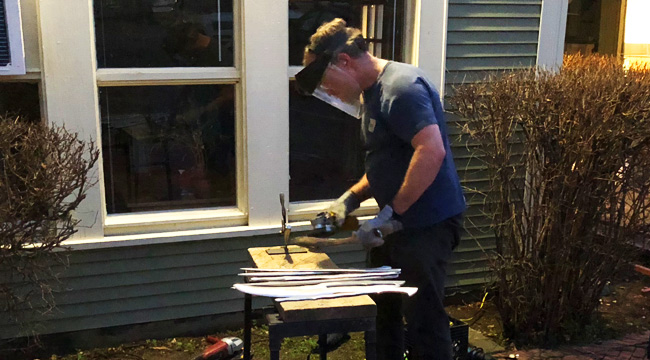
After the last of the blades is sanded, Wenderski brings out several strips of leather for us to wrap around the hilt of our swords for a final touch. Holding mine in my hand, this small 20-inch blade cast from aluminum has a much weightier feel than I’d expected. I suppose that makes sense when you consider that most of the aluminum we deal with these days is to house beer and soda. We’re used to aluminum pressed razor-thin.
There’s also the satisfying sensation of holding something that I had a hand in creating. A tried-and-true method passed down throughout time, which ultimately played a huge role in deciding the fates of kingdoms, countries, and whole civilizations over the course of history.
Before leaving, I’m hit with the sudden realization that I’d taken the bus to class without even considering whether a non-lethal (but still relatively imposing) replica of a 2300-year-old sword will be allowed on public transportation — even with the recently passed Texas law that actually allows for the open carry of large knives and swords. To prevent embarassment and loss of my new sword, I do what any normal person would do and shove the sword under my shirt, with the hilt jammed into my right armpit.
I make it home with my new aluminum kris blade, along with its wooden prototype. Despite some technological assistance — like motorized sanders, the kiln’s thermometer, and the spray-on adhesive to help the leather strips to stick — I feel like I’ve made something solid. I also have a newfound sense of awe for those countless civilizations across the globe whose survival relied on (most of) these very steps.
The sword is primeval. It’s one of humanity’s first weapons. As such, sword-and-sorcery epics will always be a part of our collective imaginations. As a result, Wenderski will always have audiences thrilled to take part in a little bit of history.






